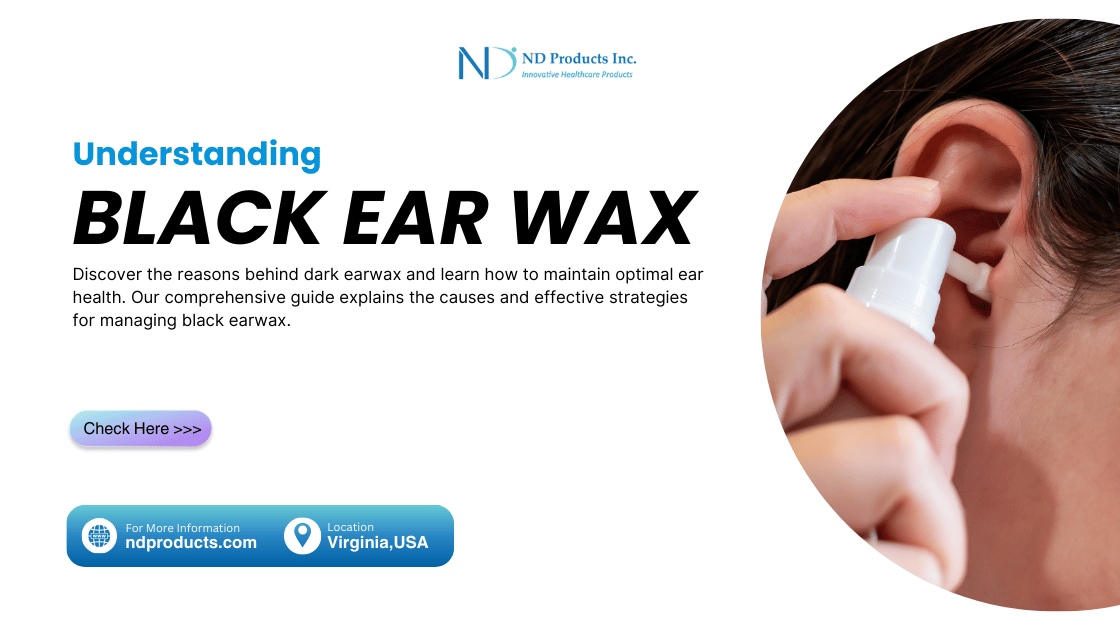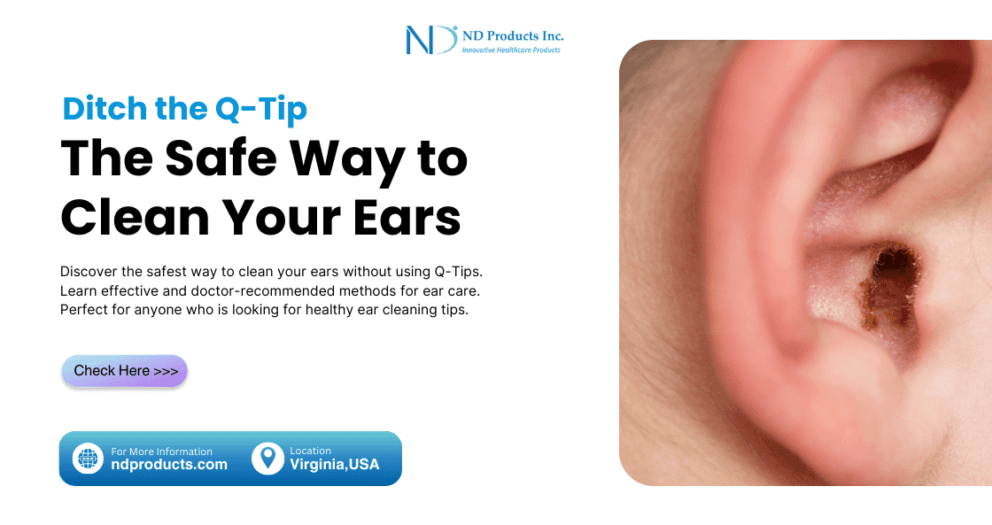Have you ever wondered why your earwax sometimes appears darker than usual? Our ND Products Inc – Innovative Healthcare Products address black earwax, which, while not common, can raise questions and concerns about your ear health. Fear not! This comprehensive guide will demystify black earwax, explaining its causes and effective ways to manage and maintain your ear health. Lets dive in!
Key Takeaways:
- Black earwax is typically caused by aging, buildup, compaction, or foreign objects.
- Wet earwax can accumulate and lead to hearing loss, while dry earwax is more beneficial for health.
- Regular checkups are essential for detecting potential issues and maintaining optimal ear health through safe cleaning techniques.
The Characteristics of Black Ear Wax
Earwax, also known as cerumen, is a natural substance made by glands in the ear canal to keep it clean and well-lubricated. It can vary in color from light brown, orange, or yellow. However, sometimes it may appear dark or even black. What causes this color change? Black earwax typically occurs due to:
- Aging
- Buildup
- Compaction
- Presence of foreign objects in the ear canal
Maintaining ear health relies on regular earwax production. However, excessive buildup can lead to earwax blockage, resulting in symptoms such as itching, a sensation of fullness in the ear, and hearing loss. This blockage is more common in certain age groups: 1 in 10 children, 1 in 20 adults, and 1 in 3 elderly individuals have an excessive amount of earwax. Now, let’s explore the factors contributing to the formation of black earwax.
Changes in Earwax Color
As we grow older, particularly in older men, the color of our earwax may shift. This darkening often occurs because aging reduces the production of earwax, leading to a buildup in the ear canal. However, it’s important to note that darkening earwax is usually not a cause for concern.
If you suspect that you have an excess of earwax or are experiencing discomfort, it’s advisable to seek advice from a medical professional. They can safely remove the excess wax using specialized techniques, promoting ear health and averting potential complications.
Accumulation and Hardening
Another factor contributing to the presence of black earwax is the accumulation and hardening of dark wax in the ear canal, which may also contain dead skin cells. Earwax buildup happens when glands in the ear canal produce excess wax or when the ear is unable to naturally remove wax effectively. As time goes on, this buildup can lead to the wax becoming hardened and taking on a darker hue.
However, avoid inserting objects into the ear canal, as this can push wax deeper inside and cause blockages.
Foreign Objects and Hearing Devices
Foreign objects like hearing aids and earbuds can also play a role in the development of black earwax. These items have the potential to push earwax deeper into the ear canal, resulting in the accumulation of dark wax. This is particularly significant for individuals who wear hearing aids regularly, as they may unknowingly push wax further into the ear canal.
To maintain your hearing health, it’s advised to clean your hearing aids using professional kits that include tools specifically made for this task. Additionally, remember to replace the wax guards in your hearing aids regularly, usually once a month.
Types of Ear Wax’es
Wet Ear Wax
Wet earwax comes in a sticky, amber, or light brown hue and is the most frequently seen type of earwax. Because it’s generated in larger amounts, moist earwax is more prone to buildup and getting lodged in the ear canal, causing problems like hearing impairment, ear discomfort, and infections.
Dry Ear Wax
On the other side, dry earwax tends to be more beneficial for ear health. It’s identified by its flaky consistency, lighter shade, and a tendency to naturally dislodge from the ear. Dry earwax is less prone to causing blockages and infections compared to its wet counterpart.
Black Ear Wax and Ear Health
While black earwax might raise concern, it’s not always an indication of poor ear health. In reality, the change in color could be due to the natural aging process of the earwax or the presence of foreign objects in the ear canal. Nonetheless, it’s important to remain attentive to any symptoms or issues that might suggest potential ear health problems.
Staying vigilant for signs of possible infections or injuries, such as pain, fever, or blood in the earwax, can help you stay proactive about your ear health and address any worries promptly.
Symptoms and Concerns
When dealing with black earwax, be alert for signs such as a dark or black color, a flaky or tar-like texture, itching, an unpleasant smell, a feeling of fullness, ringing in the ears, and ear pain. Also, keep an eye out for indications of infection or injury, such as pain, fever, or blood in the earwax.
If you notice any of these symptoms or concerns, it’s crucial to take swift action and seek medical guidance for accurate diagnosis and treatment. Monitoring your ear health closely can assist you in preserving optimal hearing and overall wellness.
Safe Methods for Removing Earwax
Using safe techniques to remove earwax is essential for maintaining ear health and preventing complications. It’s important to steer clear of cotton swabs or any other objects that might push wax further into the ear canal and lead to blockage. Instead, consider safer options like home remedies or seeking assistance from professional earwax removal services.
Whether you’re dealing with wet or dry earwax, adopting safe and efficient earwax removal methods can help ensure strong ear health, ward off infections, and maintain optimal hearing.
Home Remedies for Removing Ear wax
Home remedies for removing earwax can be a convenient and cost-effective option. Safe methods include using ear drops or gentle irrigation to soften and eliminate earwax buildup. However, it’s important to avoid using cotton swabs or other objects that can push wax further into the ear canal, potentially causing impaction and additional complications.
Make sure to adhere to the manufacturer’s instructions for any at-home earwax removal products you use, like the ND Products 4 in 1 Earwax Removal Kit. If you’re uncertain about the safety or effectiveness of a specific remedy, seek guidance from a medical professional.
Professional Ear Wax Removal
While home remedies can help, having a physician perform professional earwax removal is the safest option for maintaining ear health. Doctors are trained to carry out these procedures safely and efficiently, utilizing specialized tools and techniques to eliminate earwax without harming your ear canal.
Professional earwax removal methods encompass:
- Cerumenolytics
- Manual removal
- Irrigation
- Suctioning
Regular checkups with your doctor can ensure that your ears are well-maintained and any issues are promptly addressed.
Prevention and Maintenance
To prevent earwax buildup and maintain healthy ears, it’s essential to use appropriate cleaning methods and schedule regular checkups with your doctor. Being proactive can help you steer clear of complications such as ear infections and hearing loss.
In this section, we’ll discuss the importance of proper cleaning techniques and regular checkups in preserving your ear health and preventing issues related to dark earwax.
Regular Checkups and Monitoring
Regular visits to the doctor are essential for monitoring your ear health and addressing any emerging issues. During these checkups, your doctor will assess your ears, looking for signs of infection, inflammation, or wax buildup in your ear canals. They will also use a lighted instrument to examine your ear canal. It’s important to steer clear of DIY methods like ear candling and leave ear care to the professionals.
The recommended frequency for these checkups varies based on your age and health history. Generally, it’s advised to have checkups every 6-12 months. However, if you have a history of ear infections or other ear-related problems, or if you use hearing aids or similar devices, your doctor may recommend more frequent checkups to maintain optimal ear health.
Conclusion
In conclusion, the presence of black earwax may not always indicate a problem, but it’s important to comprehend its origins and learn effective management strategies to uphold good ear health. By adopting appropriate cleaning practices, employing safe methods for earwax removal as preventive care, and if needed scheduling checkups with your doctor, you can keep your ears healthy and minimize complications. Remember, your ears play a vital role in your communication with the world and overall well-being, so it’s crucial to give them the care they deserve!






Write a comment
Your email address will not be published. All fields are required